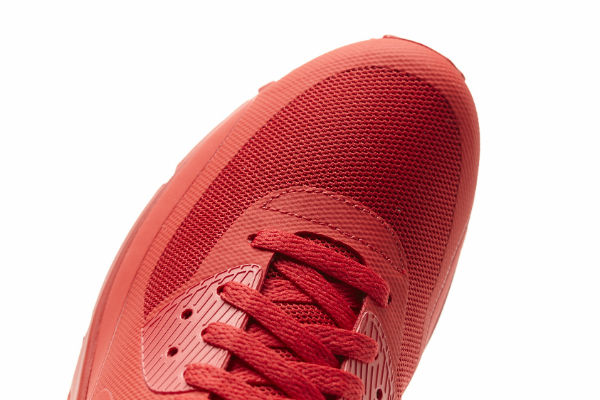Discovering and exploring the history of the Nike Air Max 90 is also to get to know a significant part of sports footwear. There may not be a more critical piece of Nike’s success than the Air Max line.
From the most avid sneakerhead to the more casual, the Air Max series is about as household as it gets. From the very beginning, the concept of Air is a mix of audacious, inspiring, and polarizing.
Even today, we see a veritable mix of opinions on the tech and the shoes that carry it. But, one thing is for sure, these things sell. Needless to say that the Nike AM90 is, as is the Nike Flyknit Trainer, or even the recent Nike Air VaporMax, one of the swoosh brand most iconic models.
Nike faces trouble every now and then when it comes to moving certain products off shelves, that downturn never seems to extend to the Air Max line. We take a look at one such banger, as the Nike Air Max 90 carries on that marvelous tradition.
Of course, we all know it’s not quite so straightforward for the Air Max series. It’s not like these are homerun releases from their early days.
On the contrary, a good amount of what we now consider classics initially see reactions of boredom or apathy. The Air Max 90 may not have suffered this sort of sales struggle at any point, but it wasn’t always rosy.
Several elements of the sneaker divided the sneakerhead community, even though consumers largely loved it. But, to understand all of that, some context is in order.
Nike Air Max 90 Carries On
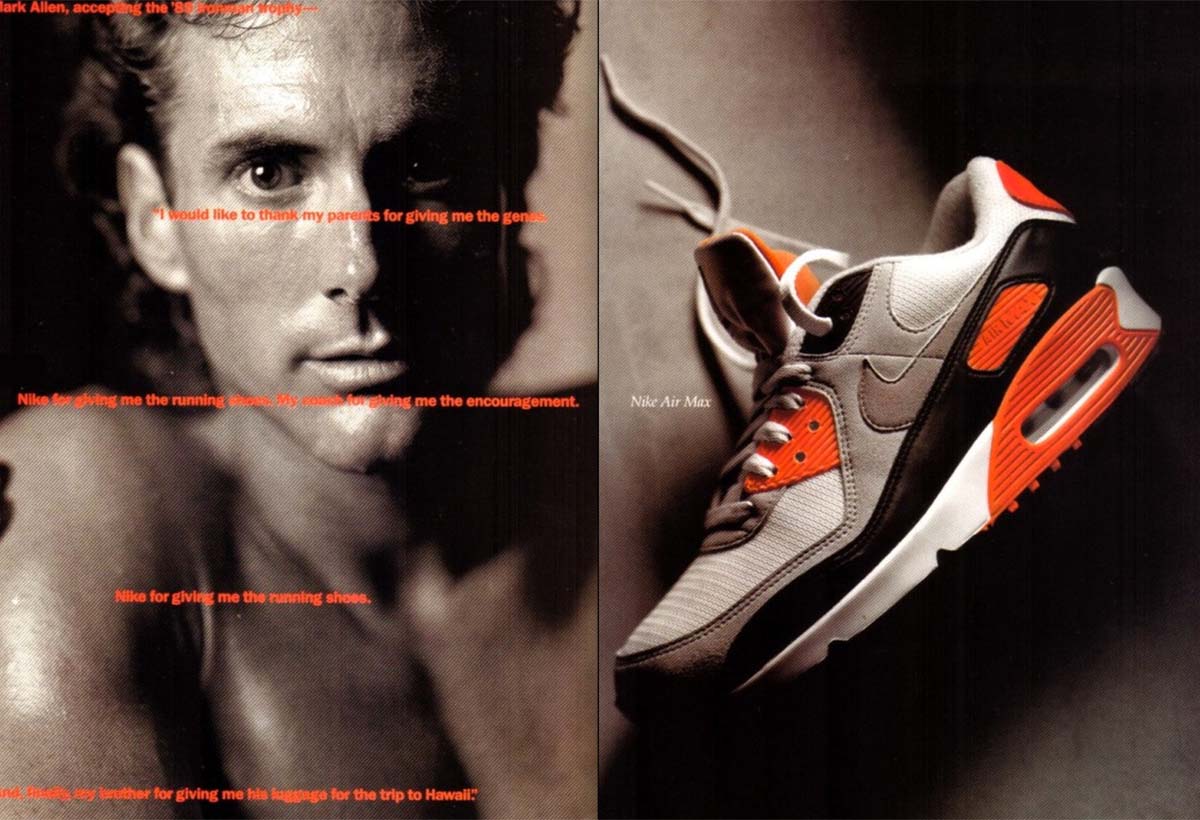
Vintage Nike Ad
Though it maintains a unique position in sneaker history, the Nike Air Max 90 carries with it some pressure. After all, this sneaker, like most others, does not release in a vacuum. In fact, it originally exists not as the AM 90, but the Air Max III.
It’s a follow-up project, a craft by Tinker, to follow up the runaway success of the Air Max 1. These are not just any old homerun hits either. Just prior to the AM 90’s release, the Air Max line is wrapping up a period that sees Nike completely take over the runners game. All of a sudden, both the performance and culture aspect of running sneakers starts and ends with the Swoosh.
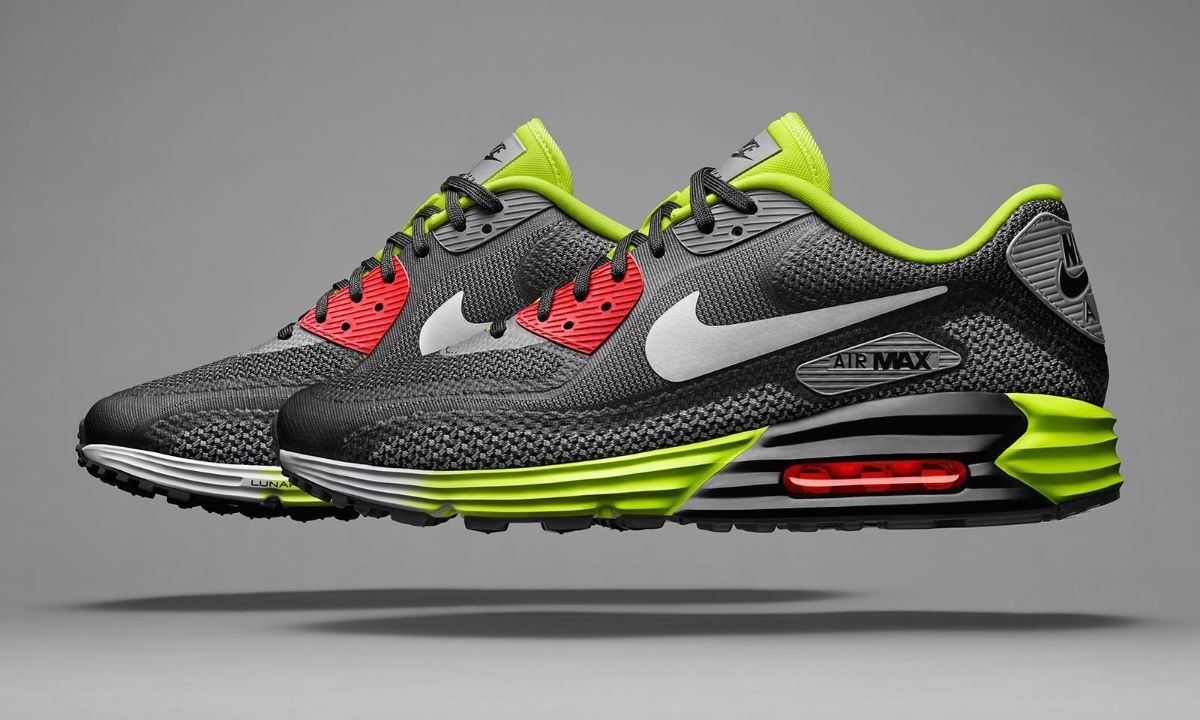
Nike Air Max Lunar 90 OG
In many ways, the Air Max 90 is a good representation of the brand’s status at this stage. Now that the AM1 sits on its throne without much in the way of a contest, it was time for some celebration.
The Air Max 90 is exactly that celebration, taking a gaudier approach to its design than its predecessor. The lower frame is no longer necessary.
This isn’t the scary world that needs to brace for the new anymore. Air is now a standard and Nike knows it. In fact, the bubble on the midsole is even easier to see on the AM 90, thanks to a relatively gigantic window.
It’s the brand’s most audacious detail on this shoe, with the higher cut and panel patterns tying for a close second.
AM90 Infrared?
One of the most memorable things about this shoe is its colorway. Consider this: the Air Max 90’s design would very likely mix in with other figures in the legendary line if it weren’t for a particular hue.
When the “Infrared” colorway introduces us to the shoe, originally releasing back in 1990, fans can’t get enough. The relatively aggressive look matches perfectly with the bright contrasting colors.
A base pairing of Grey, White, and Black play second fiddle to the more boisterous Red portion. But, there’s a catch here. As it turns out, the Nike Air Max 90 carries an OG color scheme that is, in fact, two different looks.

Nike Air Max 90 OG Infrared via Flight Club
The original 1990 drop actually features in “Hyvent Orange.” A closer look at some of the older advertising campaigns shows it. The bright accents on the OG model are clearly closer to a louder Orange than anything Red.
It’s not until 2003 that we get to see something resembling today’s “Infrared” look. A special edition of the Air Max 90 releases in Asia and Europe. This is the colorway closest to the hype-heavy scheme we know and love today. The louder Orange takes it down a notch and opts for a shade much closer to Pink.
Another classic design aspect of this release involves the midsole. This Europe and Asia exclusive represent the last time we get to see that large overbearing Air unit in the heel.
Variation
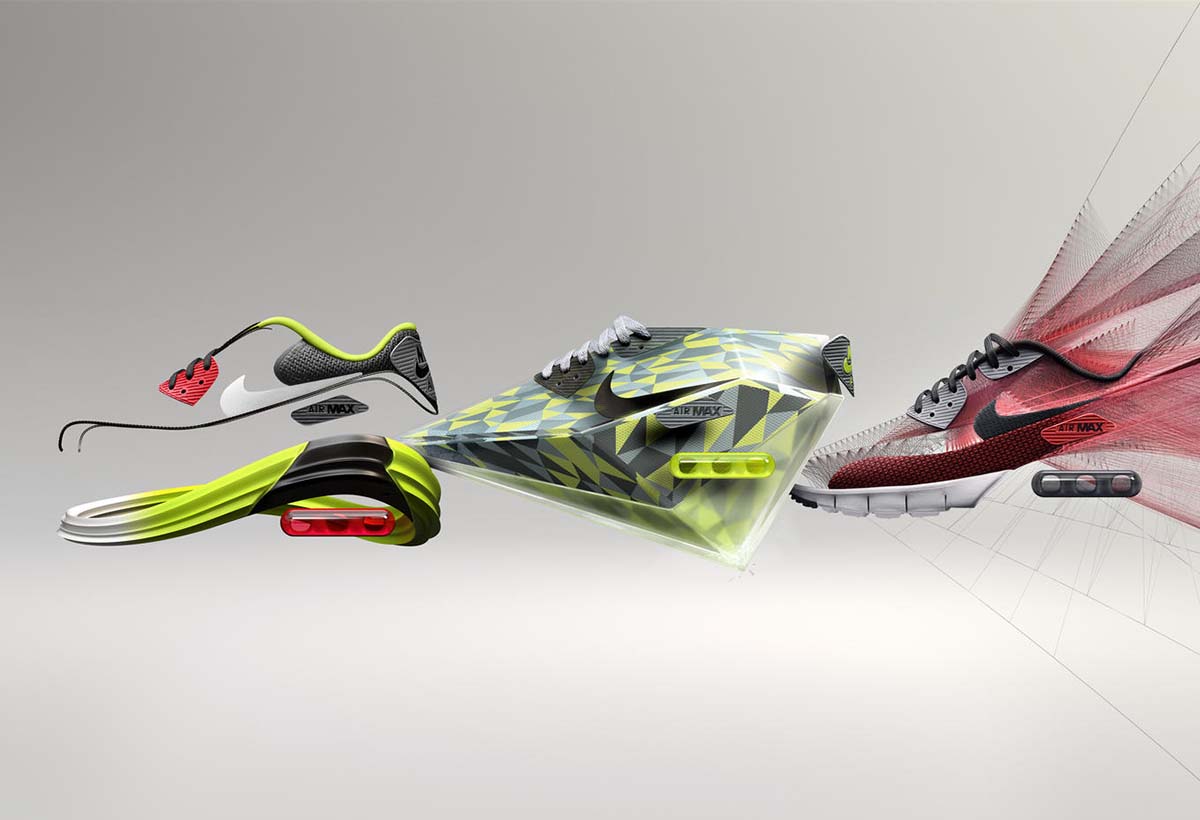
A deconstruction of the AM 90, via Nike
Then, 2006 sees things get a bit crazy for the Air Max 90. Now, most people will agree that the shameless habit of experimentation serves Nike well.
After all, it is that very same obsession with finetuning and changing that gives us some of the best silhouettes of all time. But, in the case of the AM 90’s 2006 release, there seems to be an exception.
At this point, Nike releases a super exclusive drop that includes a bunch of their legendary runners. The catch? Each shoe sports a drastically different midsole.
Nike saw this drop as a good chance to switch things up and repackage an iconic runner. Unfortunately, it was somewhat less than positively received.
The contrast between the OG and this 2006 drop are just staggering. Though most of the upper remains the same, the midsole doesn’t seem quite right. Instead of its usual Airbag, the Nike Air Max 90 carries a 360 Air casing.
This really seems like the brand tried to throw tech from the 2000’s into a legend from the 90s. The effort and intention are clear, but the execution is lacking a bit. Of course, the sneakerhead community is – and has always been – a very opinionated collective.
To be blunt, reviews for this special release are quite bad among a considerable number of fans.
Steady Through the Years
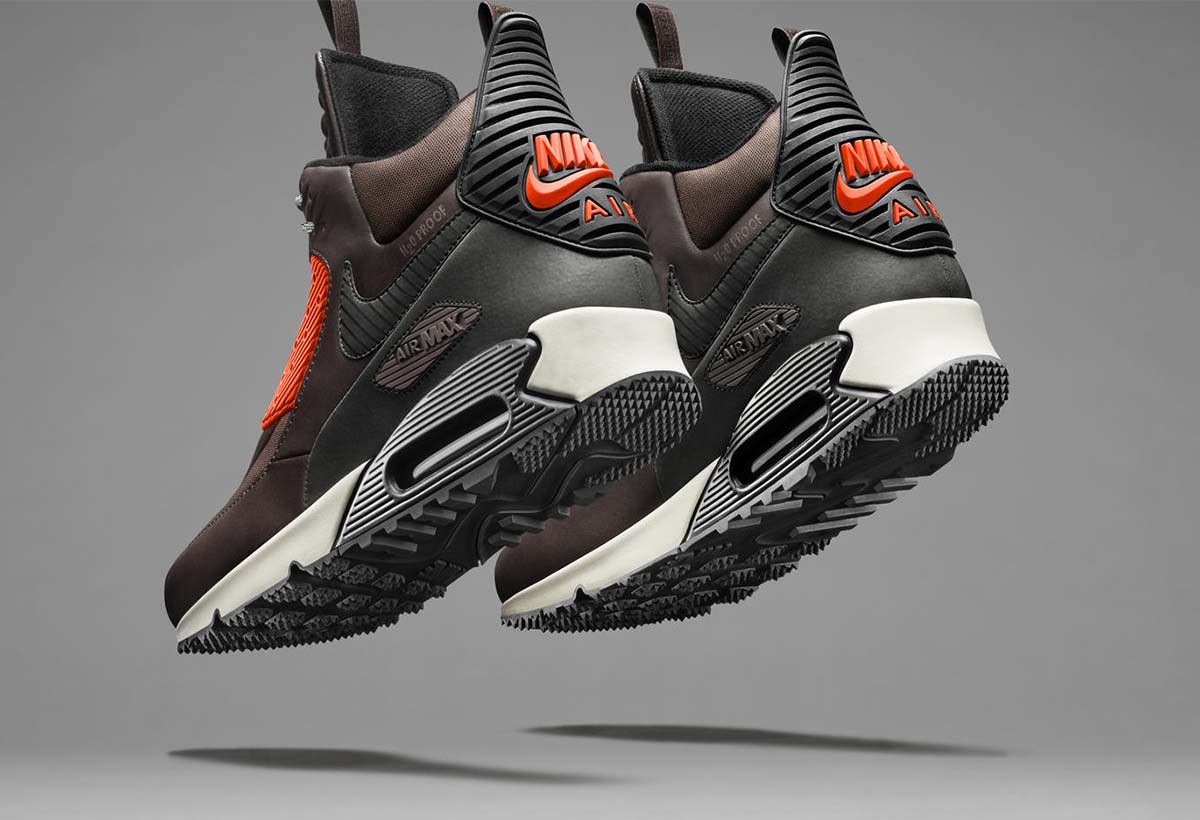
Sneakerboot edition for the Winter, via Nike
Despite those initially negative reviews, the Infrared color scheme maintains its iconic connection to the Air Max 90. This is where the cultural element of the shoe’s background starts to become more intriguing.
As it turns out, Nike’s decision – whether it’s intentional or otherwise – to reserve that color scheme for the AM 90 pays off. Over the span of a few years, Infrared becomes synonymous with the Air Max 90.
The connection is so strong that many people recognize the Air Max 90 without even immediately realizing it. Still, the Nike Air Max 90 carries on through the more modern years in all sorts of looks and material changes.
Some of the most interesting of the Air Max 90 come in the form of special or premium drops. Nike makes a habit of decking the AM 90 out in an assortment of material upgrades. Of particular interest are the winter and knit versions.
These are the two that, in a sense, seem to do the best job of symbolizing this icon’s progress through history. The Air Max 90’s origins are in advancing running sneaker technology in an audacious and showy manner.
Those two special editions, swapping out materials so fluently and easily, are great representations of the shoe’s adaptability in both form and function.
Cultural Impact

Forest Green for a muted look, via Nike
The Air Max 90 has also shown a dynamism when it comes to its place in the wider sphere of culture. Fans of the legendary runner are originally hardcore runners and people with oodles of money to blow on the latest footwear.
But, through the years, the shoe builds a following in sorts of societal groups, even gaining acceptance amongst the subculture of skateboarding. We see this same sort of flexibility with many of Nike’s legendary shoes.
It’s worth noting because it helps us predict the sneaker’s future as a retro and potential Air Max Day celebration item.
Interestingly, there is a case for seeing this sneaker as one of Nike’s less story-worthy releases. Sure, the Nike Air Max 90 carries with it some serious significance within the sneaker community.
But, it doesn’t quite pack the same marketing punch in terms of a back-story. One can argue that this is the most commercial element of the Air Max, its sole purpose being to continue the line’s rapid success. The history of the Nike Air Max 90 proves exactly that.
The preceding models and the ones that follow mostly have a higher cultural significance. Combining the AM 90’s remarkable commercial success with its lack of too many interesting facts does hold it under a different light.
Staying Power

Multicolored goodness for the ladies, via Nike
Visually, it’s not only recognizable but an infinitely style-friendly shoe as well. The Nike Air Max 90 doesn’t quite find its way to the runways very often, but it persists as an element of streetwear. With the current climate leaning more towards a bit more bulk, it’s very likely we’ll be seeing a small hiatus that drives up hype after which Nike brings back the heat.

